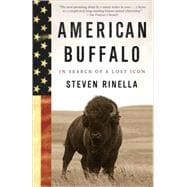
What is included with this book?
STEVEN RINELLA is the author of The Scavenger’s Guide to Haute Cuisine and a correspondent for Outside magazine. His writing has also appeared in The New Yorker, American Heritage, the New York Times, Field & Stream, Men’s Journal, and Salon.com. He grew up in Twin Lake, Michigan, and now tries to split his time between Alaska and Brooklyn, New York.
The New copy of this book will include any supplemental materials advertised. Please check the title of the book to determine if it should include any access cards, study guides, lab manuals, CDs, etc.
The Used, Rental and eBook copies of this book are not guaranteed to include any supplemental materials. Typically, only the book itself is included. This is true even if the title states it includes any access cards, study guides, lab manuals, CDs, etc.
Excerpted from American Buffalo: In Search of a Lost Icon by Steven Rinella
All rights reserved by the original copyright owners. Excerpts are provided for display purposes only and may not be reproduced, reprinted or distributed without the written permission of the publisher.